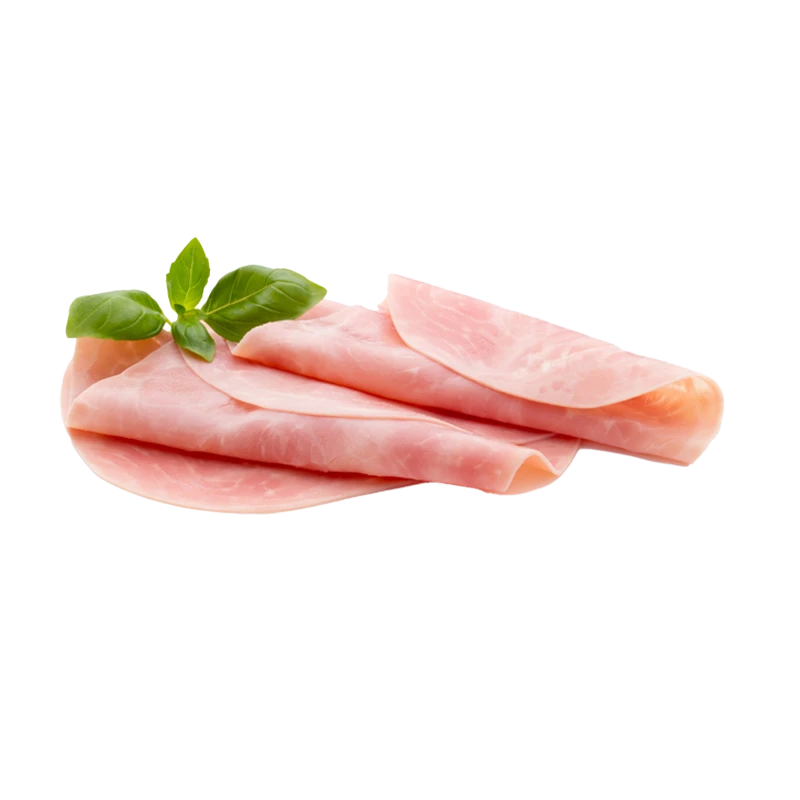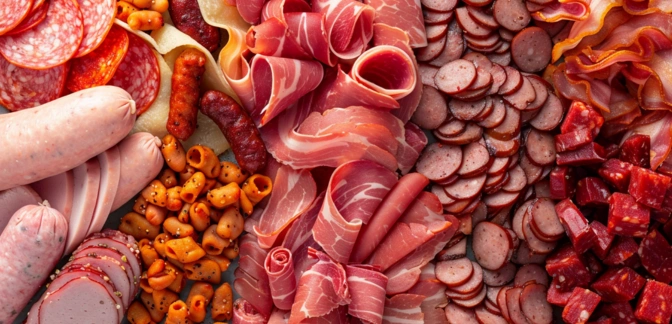Lunch Meat — Nutrients, Health Benefits, And Shopping Tips

Written by Listonic Team
Last update on September 6, 2024
Lunch meat nutrients
Nutrition facts
Amount per 100 g
Calories
🔥 157 kcal
| Nutrition per: 100 g | Value | % Daily Value* |
|---|---|---|
| Carbs | 2 g | 0.73% |
| Fiber | 0 g | - |
| Sugars | 1 g | 2% |
| Glycemic Index | 28 | - |
| Protein | 17 g | 34% |
| Sodium | 620 mg | 26.96% |
| Total Fat | 9 g | 11.54% |
*The % of Daily Value (DV) tells you how much a nutrient in a serving of food contributes to a daily diet. 2,000 calories a day is used for general nutrition advice.
17 g
🧀 Good Protein Content
28
🟢 Low Glycemic Index
Lunch meat facts & tips
Health benefits
- High in protein, essential for muscle growth, repair, and overall body function.
- Convenient and portable, making it a quick and easy source of nutrition.
- Contains essential vitamins and minerals such as Vitamin B12, iron, and zinc, which support overall health and well-being.
Health risks
- High sodium content in most lunch meats, which can contribute to hypertension and increased cardiovascular risks when consumed frequently.
- High fat content particularly in fatty cuts or processed varieties, which can raise cholesterol levels and increase the risk of heart disease.
- Presence of nitrates and nitrites used in curing lunch meats, which have been linked to an increased risk of cancer, particularly colorectal cancer.
- Potential for artificial additives such as preservatives, flavorings, or colorings in some commercial lunch meats, which may cause adverse reactions in sensitive individuals.
- Risk of contamination with harmful bacteria such as Listeria or Salmonella, particularly if lunch meat is not properly stored or handled.
How to choose lunch meat
Lunch meat should appear fresh and moist, without any discoloration or drying out at the edges. The slices should be neatly stacked and easy to separate.
Avoid lunch meat that has a slimy texture or a sour smell, which are clear indicators of spoilage. Packages that are bloated or have damaged seals should also be avoided, as the meat may be unsafe to consume.

How to store lunch meat
Lunch meat should be stored in the refrigerator, preferably in its original packaging or an airtight container. Refrigeration keeps it fresh and safe to eat for up to a week.
Air exposure can cause lunch meat to spoil quickly. Avoid leaving it uncovered, and always reseal the packaging tightly. Proper handling and storage maintain its freshness and prevent bacterial growth. Ensuring the container is airtight keeps it at optimal quality.
✅ Extra Tip
How long does it last?
Lunch meat can last for 3-5 days in the refrigerator once opened. Unopened, it can last for 2 weeks. For longer storage, lunch meat can be frozen for up to 1-2 months. Proper storage helps maintain its flavor and safety.
What to do with leftovers?
Leftover lunch meat can be used in a variety of quick and savory dishes. Slice it thinly and add to sandwiches, wraps, or salads for an easy meal, or chop it up and mix into a pasta salad with cheese and vegetables. Lunch meat is also great when used as a topping for pizzas, flatbreads, or nachos.
Use lunch meat in a breakfast scramble with eggs, cheese, and vegetables, or mix it into a casserole or quiche for added protein. If you have a lot of lunch meat, consider making a batch of lunch meat roll-ups by spreading the meat with cream cheese, rolling it up, and slicing into bite-sized pieces. Lunch meat can also be added to a grilled cheese sandwich with tomatoes and mustard, or used as a filling for stuffed peppers or omelets. For a quick snack, enjoy lunch meat with crackers and cheese, or pair it with fresh fruit for a light and satisfying treat.
👨⚕️️ Medical disclaimer
Discover products from other categories
Listonic Team
Fact-checked
Our editorial team checked this article to make sure it was accurate at the time of publishing it.
Get the top-rated shopping list app on your phone!







